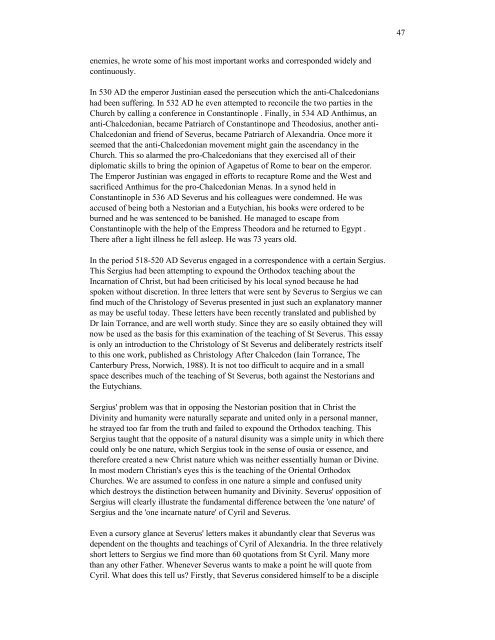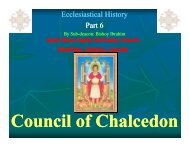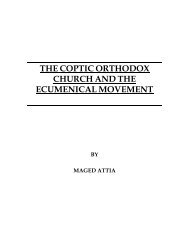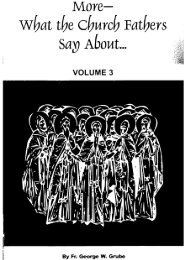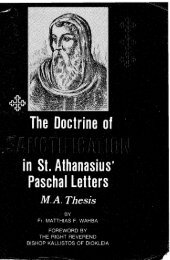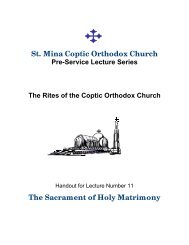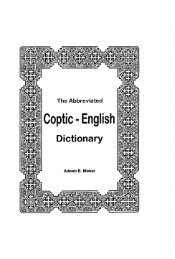Coptic interpretations of the Fourth Ecumenical Council - Saint Mina ...
Coptic interpretations of the Fourth Ecumenical Council - Saint Mina ...
Coptic interpretations of the Fourth Ecumenical Council - Saint Mina ...
Create successful ePaper yourself
Turn your PDF publications into a flip-book with our unique Google optimized e-Paper software.
enemies, he wrote some <strong>of</strong> his most important works and corresponded widely and<br />
continuously.<br />
In 530 AD <strong>the</strong> emperor Justinian eased <strong>the</strong> persecution which <strong>the</strong> anti-Chalcedonians<br />
had been suffering. In 532 AD he even attempted to reconcile <strong>the</strong> two parties in <strong>the</strong><br />
Church by calling a conference in Constantinople . Finally, in 534 AD Anthimus, an<br />
anti-Chalcedonian, became Patriarch <strong>of</strong> Constantinope and Theodosius, ano<strong>the</strong>r anti-<br />
Chalcedonian and friend <strong>of</strong> Severus, became Patriarch <strong>of</strong> Alexandria. Once more it<br />
seemed that <strong>the</strong> anti-Chalcedonian movement might gain <strong>the</strong> ascendancy in <strong>the</strong><br />
Church. This so alarmed <strong>the</strong> pro-Chalcedonians that <strong>the</strong>y exercised all <strong>of</strong> <strong>the</strong>ir<br />
diplomatic skills to bring <strong>the</strong> opinion <strong>of</strong> Agapetus <strong>of</strong> Rome to bear on <strong>the</strong> emperor.<br />
The Emperor Justinian was engaged in efforts to recapture Rome and <strong>the</strong> West and<br />
sacrificed Anthimus for <strong>the</strong> pro-Chalcedonian Menas. In a synod held in<br />
Constantinople in 536 AD Severus and his colleagues were condemned. He was<br />
accused <strong>of</strong> being both a Nestorian and a Eutychian, his books were ordered to be<br />
burned and he was sentenced to be banished. He managed to escape from<br />
Constantinople with <strong>the</strong> help <strong>of</strong> <strong>the</strong> Empress Theodora and he returned to Egypt .<br />
There after a light illness he fell asleep. He was 73 years old.<br />
In <strong>the</strong> period 518-520 AD Severus engaged in a correspondence with a certain Sergius.<br />
This Sergius had been attempting to expound <strong>the</strong> Orthodox teaching about <strong>the</strong><br />
Incarnation <strong>of</strong> Christ, but had been criticised by his local synod because he had<br />
spoken without discretion. In three letters that were sent by Severus to Sergius we can<br />
find much <strong>of</strong> <strong>the</strong> Christology <strong>of</strong> Severus presented in just such an explanatory manner<br />
as may be useful today. These letters have been recently translated and published by<br />
Dr Iain Torrance, and are well worth study. Since <strong>the</strong>y are so easily obtained <strong>the</strong>y will<br />
now be used as <strong>the</strong> basis for this examination <strong>of</strong> <strong>the</strong> teaching <strong>of</strong> St Severus. This essay<br />
is only an introduction to <strong>the</strong> Christology <strong>of</strong> St Severus and deliberately restricts itself<br />
to this one work, published as Christology After Chalcedon (Iain Torrance, The<br />
Canterbury Press, Norwich, 1988). It is not too difficult to acquire and in a small<br />
space describes much <strong>of</strong> <strong>the</strong> teaching <strong>of</strong> St Severus, both against <strong>the</strong> Nestorians and<br />
<strong>the</strong> Eutychians.<br />
Sergius' problem was that in opposing <strong>the</strong> Nestorian position that in Christ <strong>the</strong><br />
Divinity and humanity were naturally separate and united only in a personal manner,<br />
he strayed too far from <strong>the</strong> truth and failed to expound <strong>the</strong> Orthodox teaching. This<br />
Sergius taught that <strong>the</strong> opposite <strong>of</strong> a natural disunity was a simple unity in which <strong>the</strong>re<br />
could only be one nature, which Sergius took in <strong>the</strong> sense <strong>of</strong> ousia or essence, and<br />
<strong>the</strong>refore created a new Christ nature which was nei<strong>the</strong>r essentially human or Divine.<br />
In most modern Christian's eyes this is <strong>the</strong> teaching <strong>of</strong> <strong>the</strong> Oriental Orthodox<br />
Churches. We are assumed to confess in one nature a simple and confused unity<br />
which destroys <strong>the</strong> distinction between humanity and Divinity. Severus' opposition <strong>of</strong><br />
Sergius will clearly illustrate <strong>the</strong> fundamental difference between <strong>the</strong> 'one nature' <strong>of</strong><br />
Sergius and <strong>the</strong> 'one incarnate nature' <strong>of</strong> Cyril and Severus.<br />
Even a cursory glance at Severus' letters makes it abundantly clear that Severus was<br />
dependent on <strong>the</strong> thoughts and teachings <strong>of</strong> Cyril <strong>of</strong> Alexandria. In <strong>the</strong> three relatively<br />
short letters to Sergius we find more than 60 quotations from St Cyril. Many more<br />
than any o<strong>the</strong>r Fa<strong>the</strong>r. Whenever Severus wants to make a point he will quote from<br />
Cyril. What does this tell us? Firstly, that Severus considered himself to be a disciple<br />
47


